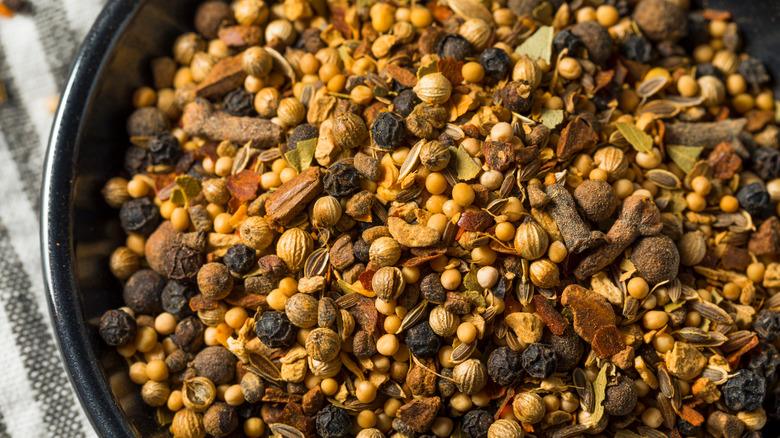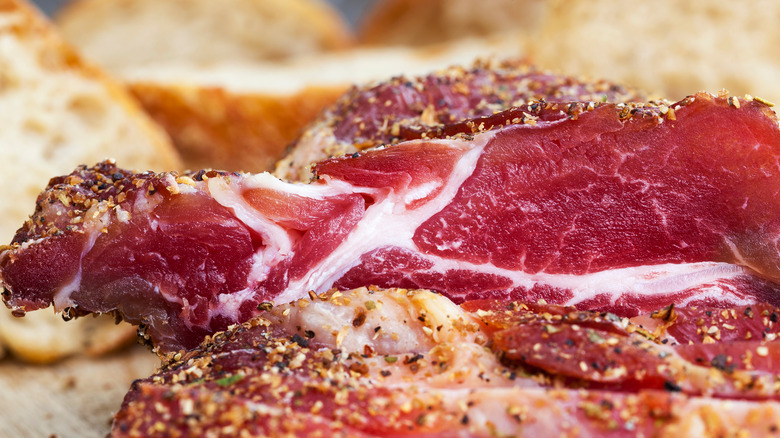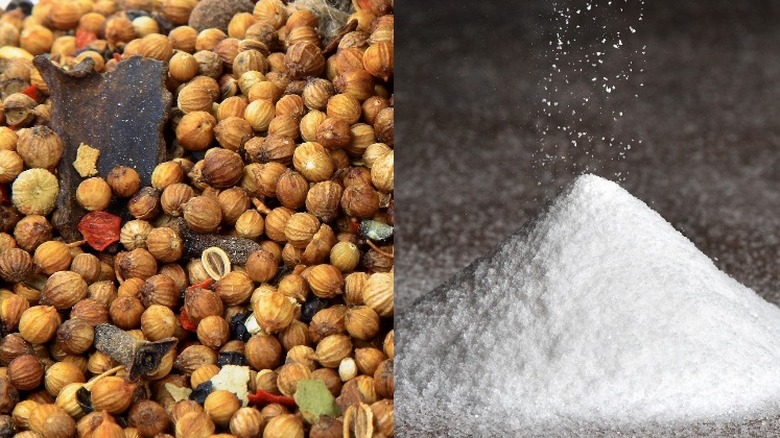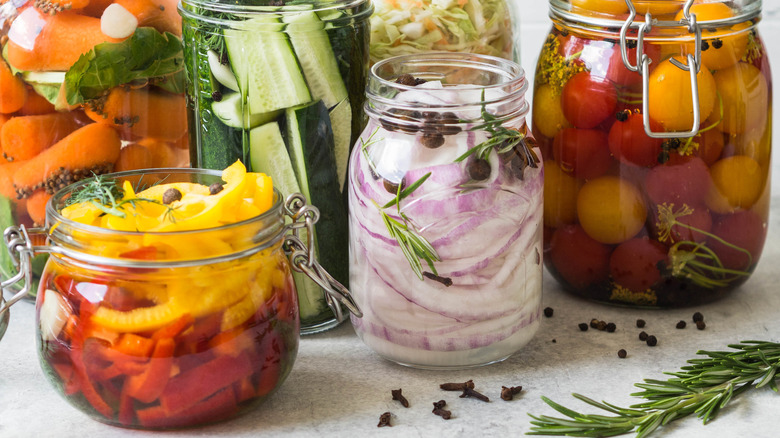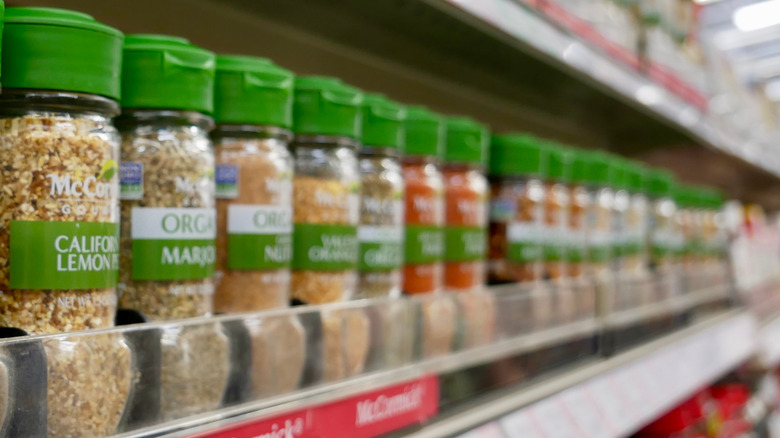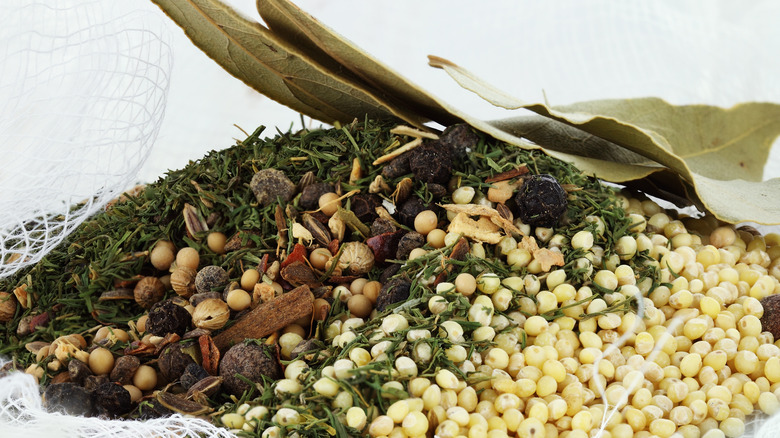What Is Pickling Spice And What Is It Used In?
While reading through pickling recipes, you may see one ingredient that seems both straightforward and confusing: pickling spice. Is that one ingredient or a mixture? Why do you need it? Where do you find it? Here's what you need to know.
Pickling spice is a mixture of dried spices in a blend that adds flavor to pickles, and other dishes like corned beef, as well (via AllRecipes). It's usually easy to find in spice aisles at the grocery store, and may be included in canning and preserving displays at the end of summer. Like many spice blends, the exact ingredients can vary depending on the brand, or on which components are emphasized to give the blend more sweetness, more heat, etc. The ingredients listed in McCormick brand pickling spice include mustard seeds, cinnamon, cardamom, allspice berries, cloves, and bay leaves. Other grocery store brands of bottled pickling spice will likely have a similar assortment.
When you look at pickling spice you'll see a coarse and jumbled mixture. The round, whole spices in the blend could be coriander, mustard seeds, peppercorns, or larger allspice berries (via How Stuff Works). Whole cloves are dark brown and look like little stems. Dried bay leaves will be in the mix as broken or crumbled pieces, and you may see pieces of cinnamon stick, too.
What does pickling spice taste like?
With six or even more different spices in the blend, pickling spice brings an amazing flavor to dishes. AllRecipes describes the blend as "sweet and spicy," which makes sense when you think about what's in it. Coriander seeds are citrusy, and cinnamon is commonly used in both savory and sweet dishes (via Kitchn). The distinct flavor of allspice is part of many sweet recipes, but also integral to spicy jerk chicken. The flavor of cloves is spicy but also beautiful in fragrant gingerbread and holiday sweets. Peppercorns are strong and spicy, and bay has a delicate "woodsy" flavor. Using store-bought versions of pickling spice gives your pickles and other foods a complex play of flavors, heat, and sweetness. Creating your own blend means you're in control of just how hot or sweet it is.
The spices in the blend are whole, in order to impart as much of these flavors as possible. The Spice Guy shares that whole spices are more potent with longer lasting flavor. This is especially important in pickling recipes, where spices have to hold up first in boiling-hot brines and then through long periods of curing.
What is pickling spice used for?
To make pickles, the ingredients that may first come to mind are the vinegar used for preserving, and the cucumbers — or onions, peppers, peaches, carrots, or whatever produce that you're pickling (via Almanac). But as Preserve And Pickle points out, without something more you'll just have sourness and little flavor. Adding pickling spice to the brine infuses whatever you're pickling with complex flavors that can add a sweet or spicy kick.
There are other uses for pickling spice, too! Delicious Table says the spice blend can be used to flavor brines for meats, like a classic corned beef and cabbage dinner, or for pork chops. To do this, you let the uncooked meats rest in a salty water bath before cooking them. The salt helps tenderize the meat and infuse it with flavor. With pickling spice in the solution, those potent flavors penetrate the meats, too. You can also use pickling spices to flavor braised meat dishes like beef stew, or to season a pot of rice or simmering beans.
Pickling spice versus pickling salt
Both pickling spice and pickling salt are ingredients often called for in pickle recipes. Home cooks attempting the recipes for the first time often wonder if they can just buy one and not the other. While both are used in pickling, they're very different. Pickling spice doesn't usually contain any salt at all: It's just a blend of various spices and herbs that brings flavor to the pickles or dish. Pickling salt is used to help draw moisture from the vegetables, which allows them to stay firmer for a longer period (via Almanac). It contains only salt, but it's more finely ground than table salt, so it dissolves more easily when making a brine (via Kitchn). Pickling salt is also free of iodine or additives that prevent caking, because these can make pickles look discolored or cloudy. But pickling salt alone won't add as much flavor to the dish, and this is where the pickling spices come in. Even though there are substitutes for each of these ingredients, they can't be substituted for each other.
How to use pickling spice
Pickling spice is made up of whole spices for a reason: As The Spice Guy notes, whole spices have more potent and long-lasting flavor than ground, and this will give you better tasting results. Add your pickling spice in its coarse, whole state to the brining liquid for your pickles (via Preserve And Pickle). They can be strained out before sealing the pickles, and Preserve And Pickle shares that the spices are often tied up in a cheesecloth bag to make them easy to remove. You can also leave the whole spices in the brine for a rustic, homemade look.
Add pickling spice this same way — tied up in a cheesecloth, teabag, or coffee filter sachet — to the braising liquids for meats, or to the cooking liquids for rice and beans (via Garlic Delight). Use a pickling spice sachet to season the broth for soups and stews, or to flavor homemade stock along with meat and vegetables. If you have a spice grinder you can grind some of your pickling spice into a finer texture, and then use it as part of a dry rub on meats or to sprinkle over roasting vegetables.
Where to find pickling spice
When it's time to buy your pickling spice, start at your local grocery store. Users on Houzz report that they find pickling spice at their local stores, as well as retailers like Walmart. If you're having trouble finding it in the spice aisle, ask your store where they keep their canning supplies. Pickling spice and pickling salt may be shelved with canning supplies like mason jars, lids, and stockpots. Other stores that carry canning supplies (and might have pickling spice) include hardware stores and home and garden stores like Tractor Supply. The spice blend will be sold like other spices in jars, larger plastic containers, or in bags. If you have any bulk spice stores nearby, they're worth checking, too. As some users on Houzz note, if canning and vegetable gardening aren't popular in your area, you might have a harder time finding a store that carries pickling spice. That's when it's worth looking at online resources like Amazon and spice retailers. Here's another option you can consider when you need pickling spice: Make your own!
How to make your own pickling spice
Premixed pickling spices are a great way to get started with pickling, but don't be afraid to put together your own blend. It gives you control over the flavors for your pickles. Do you love spicy pickles? Add some jalapenos or hot spices of your choice. If you hate the taste of cloves, you can leave them out of your spice mix. Or bump up the ratio of cinnamon, clove, and allspice for a batch of sweet pickles.
Delicious Table says other spices you can consider adding are juniper berries, ground ginger, whole anise seed pods, and whole cardamom. Foodie Crush likes to add dill seeds, fennel seeds, and whole cloves of garlic to the pickling spices. If you have a well-stocked spice cabinet, this is a perfect opportunity to add some of your favorite whole spices to your pickles — and maybe even clean out a few near-empty jars in the process.
